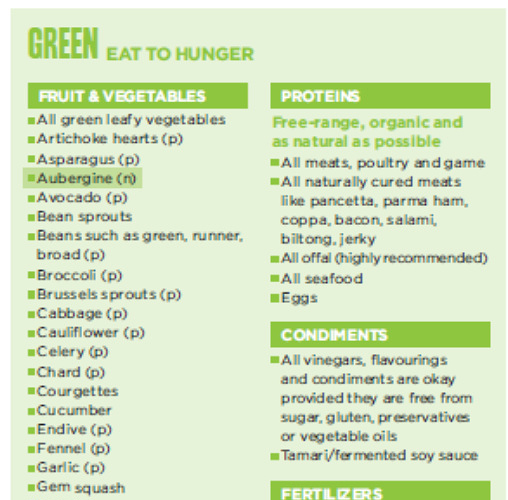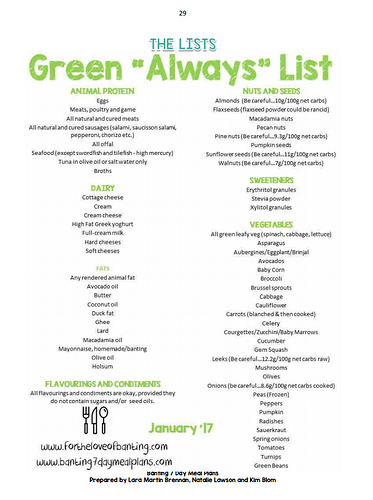More then 50% cals from protein would be really hard to do with real foods that people are actually likely to eat. I eat mostly meat and I doubt I’m anywhere near that. IMO Noakes kinda arguing a straw man over the the concern of protein intake. Arctic explorer guy was a weird fringe case.
Protein will not make you fat, article
A lot of chicken and turkey can get you there. Better to throw the chicken in a salad with a lot of olive oil
For sure, bodybuilders probably get there during their pre competition cut, but it’s only a temporary hack. Definitely an unsustainable diet for people, you would have to have no access to fat to pursue it long term.
Good question. The answer may depend on who you ask…& I may not be the best person since I’m a US based practitioner who had to pick up up via podcasts & info on websites rather than from a coach.
Banting (Tim Noakes’s diet) is driven off of color coded lists and is a type of LCHF diet & is mainly popular in South Africa and Oceania.
Green list (low carb / low glycemic load) eat as much as you want to satiety
Orange list (moderate carb/glycemic load) eat a sparingly.
Red list (high carb/glycemic load) don’t eat.
Banting 2.0 has added “light red” (almost never) and “grey” (jury still out items).
Key differences between “Banting” and “Keto”:
Keto is < 20 g carbs / day.
Banting typically states a 25 to 50 g carbs/day range.
Keto diet practitioners are a bit more likely to focus on measuring ketones.
Banting diet practitioners are more likely just to assume they are in ketosis (or close enough) based off of the lists and not sweat it.
My impression is also that there is more emphasis in Banting on the hypothalamus / appestat resetting after processed carbs are removed from the diet. Once that happens, the appestat will tell us what we need to eat (like say more or less protein based off our our needs and activity levels) rather than a calculation based off of our lean body mass (though that is used also for beginners I hear to give them a rough idea before the appestat starts functioning correctly again).
Green list should be pretty much the same. It’s a flavor of keto…just a little different thought process.
For sure. I’m currently doing an n=1 experiment. I’m letting my taste buds decide how much lean vs fat for my meals. In the past I’ve shied away from too much protein because my toes and the soles of my feet would start to hurt. I’ve since read The Salt Fix and done further research on sodium and have found that taking in adequate salt prevents the toe and sole pain. Anyway, with my current experiment, my taste buds have been wanting higher protein, about 35-40%. I’ll keep you posted on whether or not I gain body fat.
I wonder what the results would have been if all three groups were fed low carb.
Would that also change the way the body uses the protein ?
The popular question for sure. My recent investigation of all things mTOR says it will jack up mTOR and shut off autophagy (bad thing) increase inflammation (bad thing).
Rosedale is recommending 0.5 grams/kg lean body mass per day if Type II, 0.75 gms/day for the rest. For me that’s 40gms/day. Been that way since Aug 1. Bench press weight up 35%, leg lift weight up 45%. NSAID consumption = 0.
Former Atkin’s veteran here personal record was a 1.5lb prime rib at Victoria Station for dinner at peak. Lotsa protein, low carb = no sustained weight loss.
So I’ve been conducting an n=1 experiment for four weeks now. Every day I’ve been eating 140-150 grams of protein and fat to satiety. Once or twice a week I might throw in a bit of peeled cucumber or salsa. I have a daily cup (sometimes 2) of my tamari broth.
Why have I been doing this? Because: 1) I like n=1 experiments; 2) doing mod protein/high fat is good but I felt like my body fat% wasn’t improving; 3) I had a hard time staying in the macro guidelines.
How am I gauging the benefits or down-sides of higher protein? 1) Pain in feet from uric acid; 2) hunger level; 3) weight; 4) body fat; 5) energy; 6) health in general; 7) bowel movements.
What I’ve been eating and doing for four weeks: 1) Usually 2, sometimes 3, meals a day; 2) Around 140-150 grams protein and then fat to satiety; 3) tamari broth daily; 4) exercise consisting of 1 hour of drums 5 days a week, 1.5 miles a day walking, pretty much just NEAT; 5) 1 tsp Natural Calm in hot water every night before bed.
Results:
- No pain in feet
- Hunger greatly reduced; I have difficulty eating more than 1300 cals average a day
- Dropped a whopping 1 pound
- Lost an inch and a half
- Energy is good, but not as good as when eating higher calories with high fat.
- Health is great, although I think I’ve discovered I may have a tomato intolerance (I’ll have to experiment with that later)
- Easy BMs once every 2-3 days, unless I don’t get my sodium in, then it might be 3-4 days between each, still easy though.
So all in all, a successful experiment. I’ll probably continue doing this for a while since it seems to work for me.


